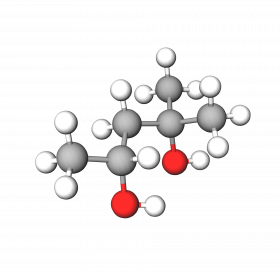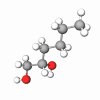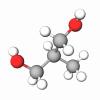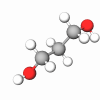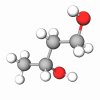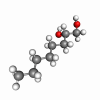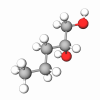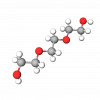Hexylene glycol is a diol (with two hydroxy groups at 2 and 4 positions), a colorless liquid with a mildly sweet odor and oily consistency. In nature, it is found in the tobacco plant (Nicotiana tabacum). For industrial purposes hexylene glycol is formed from the achiral reagents, diacetone alcohol, and hydrogen, producing equal amounts of enantiomeric products.
Commercial hexylene glycol contains > 99% 2-methyl-2,4-pentanediol and is described as a racemic mixture containing equal amounts of two enantiomers. The largest end use for hexylene glycol is in industrial coatings, as a solvent plasticizer in varnishes, lacquers, paints, and paint strippers, accounting for about 45% of the total production.
Hexylene glycol is also used as a chemical intermediate in chemical syntheses, downhole lubricant for natural gas and oil fields, hydraulic fluid, antifreeze, fuel additive, the solvent in dyes and inks, leather and textile processing, industrial and household cleaners, and in cosmetics.
Hexylene glycol is a skin and eye irritant depending on concentration. It is not readily absorbed through the skin. The American Conference of Governmental Industrial Hygienists (ACGIH) set a Threshold Limit Value (TLV) of 25 ppm for hexylene glycol to avoid eye irritation, which has been reported in volunteer studies at 50 ppm in addition to nasal irritation and respiratory discomfort at 100 and 1000 ppm (OECD 2001). The ceiling concentration set by the National Institute for Occupational Safety and Health is also 25 ppm (RTECS). Consumer exposure occurs mostly from the use of cosmetics, cleaning products, antifreeze, and hydraulic fluids containing hexylene glycol. Hexylene glycol has been detected in apples undergoing the ripening process, thereby providing another source of exposure by ingestion or inhalation (Mattheis et al. 1991).In personal care applications, Hexylene glycol at low concentrations can be used as a solvent, humectant, viscosity-controlling agent, and preservative booster. It is usually coupled with other ingredients like silicones and other glycols to reduce its irritation potential or classic preservatives like phenoxyethanol to enhance antimicrobial activity in very low concentrations.
Environmental Fate
The EPIWIN/APO model (U.S. EPA) estimates that the atmospheric photodegradation (reaction with hydroxyl radicals) half-life of hexylene glycol is 9 hours, based on 12 hours of sunlight/day. Glycols have no hydrolyzable groups and are generally not susceptible to hydrolysis in water under neutral conditions at ambient temperatures. The estimated Henry’s Law Constant of 2.94 x 10-8 atm-m3/mole for hexylene glycol indicates it has limited potential to partition from water to air. The environmental distribution of hexylene glycol, as predicted by Mackay Level I fugacity modeling, is 0.169% in air, 99.5% in water, 0.335% in soil, and 0.0074% in sediment.
Although there are insufficient experimental data to determine whether hexylene glycol is readily biodegradable, it is considered at least inherently biodegradable. With a predicted bioconcentration factor of 3.162 and Log KOW of 0.58, hexylene glycol is not expected to bioaccumulate. Hexylene glycol is therefore unlikely to persist in the environment (OECD, 2001).
